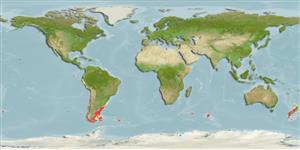Malacostraca |
Amphipoda |
Eusiridae
Environment: milieu / climate zone / djupintervall / distribution range
Ekologi
; djupintervall 0 - 120 m (Ref. 84663). Polar
Southern Ocean: East and West Antarctic, South Georgia, Sub-Antarctic Islands and Magellan provinces. Subtropical to polar.
Length at first maturity / Size / Weight / Age
Könsmognad: Lm ? range ? - ? cm
Maximum depth from Ref. 116836. This epibenthic species (Ref. 84663) is found on algae from hard bottoms (Ref. 87801).
Life cycle and mating behavior
Könsmognad | Reproduktion | Lek | Eggs | Fecundity | Larvae
Members of the order Amphipoda are gonochoric and sexually dimoprhic (males larger than females). Mating behavior: Males locate potential partners with the aid of their antenna to detect the pheromones released by the females; the male then rides or carries the female until the latter is ready to molt. When the female is ready, the male pushes the sperm into the marsupium and releases the female afterwards. A few hours later, the female releases her eggs into the marsupium for fertilization. Life cycle: Eggs are brooded in the marsupium. Eggs hatch into juveniles and remain in the marsupium for a few days. Each species undergo 20 molts at most, i.e., 1-year long life cycle.
De Broyer, C., J.K. Lowry, K. Jazdzewski and H. Robert 2007 Catalogue of the Gammaridean and Corophiidean Amphipoda (Crustacea) of the Southern Ocean, with distribution and ecological data. In C. De Broyer (ed.), Census of Antarctic Marine Life: Synopsis of the Amphipoda of the Southern Ocean. Vol. I. Bulletin de l'Institut royal des Sciences naturelles de Belgique van het koninklijk Belgisch Instituut voor Natuurwetenschappen. Biologie 77(suppl.1):1-325. (Ref. 84663)
IUCN Red List Status
(Ref. 130435: Version 2025-1)
CITES status (Ref. 108899)
Not Evaluated
Not Evaluated
Threat to humans
Harmless
Human uses
| FishSource |
Verktyg
Ytterligare information
Trophic EcologyFood items (preys)FödosammansättningFödointagPredatorer PhysiologySyreförbrukning
Human RelatedStamps, coins, misc.
Internet-källor
Estimates based on models
Preferred temperature
(Ref.
115969): 6.8 - 16.1, mean 10.7 (based on 184 cells).
